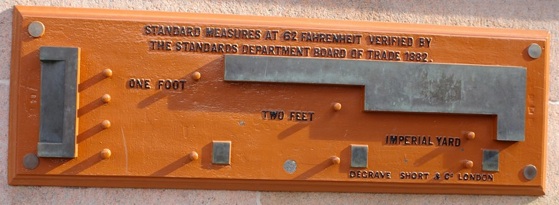
In the times before you could buy a ruler in your local stationers or a tape measure in a hardware store, people estimated the length of objects from the lengths of parts of their body. For example:
(i) An inch is roughly the length of the end of your thumb (i.e. from the joint to its end)
(ii) A foot is what you would expect, i.e. the length of a foot, originally the length of the Kings foot.
(iii) A yard was a Bowmans pull (i.e. from your breastbone to your hand).
Such rules of thumb are adequate if all that is required is a rough estimate of the length of an object, but you can imagine the arguments that would ensue if you were buying or selling cloth for example. If you are selling cloth you would make the most profit if you used someone with short arms as your measure, however if you are a tailor buying cloth, you would prefer someone with long arms! To ensure fair trading, standards of measurements were provided in public places in towns and cities throughout the UK.
The chain is the unit of measure used by surveyors, as recently as 50 years ago a young apprentice surveyor was sent to George Square to check the length of his company’s chain against the length of the standard chain. In the days before metrication every child had to learn 3 feet make a yard, 22 yards make a chain, 10 chains make a furlong and 8 furlongs make a mile.
There are three sets of measurement standards to be found in George Square:
(a) The standard inch, foot, 2 foot, and 3 foot are mounted on the wall of the City Chambers (locate them on the right hand side of the entrance to the City Chambers as you face the building with your back to the Square).
(b) There is a standard chain with its links in the Square (locate these between the benches and the grassed area on the east side of square.)
(c) 100 feet. (Again these are located beside the benches, this time at the grassed area at the west side.)
Location: George Square & City Chambers west wall
Erected: 1882
Podcast:
See also:




